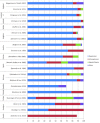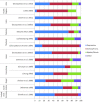Contemporary use and practice of electroconvulsive therapy worldwide
- PMID: 22741102
- PMCID: PMC3381633
- DOI: 10.1002/brb3.37
Contemporary use and practice of electroconvulsive therapy worldwide
Abstract
To explore contemporary (from 1990) utilization and practice of electroconvulsive therapy (ECT) worldwide. Systematic search (limited to studies published 1990 and after) was undertaken in the databases Medline, Embase, PsycINFO, SveMed, and EBSCO/Cinahl. Primary data-based studies/surveys with reported ECT utilization and practice in psychiatric institutions internationally, nationally, and regionally; city were included. Two reviewers independently checked study titles and abstracts according to inclusion criteria, and extracted ECT utilization and practice data from those retrieved in full text. Seventy studies were included, seven from Australia and New Zealand, three Africa, 12 North and Latin America, 33 Europe, and 15 Asia. Worldwide ECT differences and trends were evident, average number ECTs administered per patient were eight; unmodified (without anesthesia) was used in Asia (over 90%), Africa, Latin America, Russia, Turkey, Spain. Worldwide preferred electrode placement was bilateral, except unilateral at some places (Europe and Australia/New Zealand). Although mainstream was brief-pulse wave, sine-wave devices were still used. Majority ECT treated were older women with depression in Western countries, versus younger men with schizophrenia in Asian countries. ECT under involuntary conditions (admissions), use of ambulatory-ECT, acute first line of treatment, as well as administered by other professions (geriatricians, nurses) were noted by some sites. General trends were only some institutions within the same country providing ECT, training inadequate, and guidelines not followed. Mandatory reporting and overall country ECT register data were sparse. Many patients are still treated with unmodified ECT today. Large global variation in ECT utilization, administration, and practice advocates a need for worldwide sharing of knowledge about ECT, reflection, and learning from each other's experiences.
Keywords: Electroconvulsive therapy; epidemiology; health care surveys; mental disorders; review; systematic.
Figures






Similar articles
-
A survey of the practice of electroconvulsive therapy in Asia.J ECT. 2010 Mar;26(1):5-10. doi: 10.1097/YCT.0b013e3181a74368. J ECT. 2010. PMID: 19444137
-
Beyond the black stump: rapid reviews of health research issues affecting regional, rural and remote Australia.Med J Aust. 2020 Dec;213 Suppl 11:S3-S32.e1. doi: 10.5694/mja2.50881. Med J Aust. 2020. PMID: 33314144
-
Unilateral or bilateral electroconvulsive therapy for depression? A survey of practice and attitudes in Australia and New Zealand.Med J Aust. 1991 Jul 1;155(1):9-11. doi: 10.5694/j.1326-5377.1991.tb116367.x. Med J Aust. 1991. PMID: 2067461
-
Electroconvulsive therapy for treatment-resistant schizophrenia.Cochrane Database Syst Rev. 2019 Mar 19;3(3):CD011847. doi: 10.1002/14651858.CD011847.pub2. Cochrane Database Syst Rev. 2019. PMID: 30888709 Free PMC article.
-
Electroconvulsive therapy in South Asia: Past, present, and future.Asian J Psychiatr. 2024 Feb;92:103875. doi: 10.1016/j.ajp.2023.103875. Epub 2023 Dec 17. Asian J Psychiatr. 2024. PMID: 38157713 Review.
Cited by
-
Turkish Validity and Reliability Study of the ECT Perception and Knowledge Scale.Noro Psikiyatr Ars. 2023 Feb 26;60(1):55-61. doi: 10.29399/npa.28144. eCollection 2023. Noro Psikiyatr Ars. 2023. PMID: 36911565 Free PMC article.
-
Electroconvulsive therapy: 80 years old and still going strong.World J Psychiatry. 2019 Jan 4;9(1):1-6. doi: 10.5498/wjp.v9.i1.1. eCollection 2019 Jan 4. World J Psychiatry. 2019. PMID: 30631748 Free PMC article.
-
Management of Treatment-Resistant Depression: Challenges and Strategies.Neuropsychiatr Dis Treat. 2020 Jan 21;16:221-234. doi: 10.2147/NDT.S198774. eCollection 2020. Neuropsychiatr Dis Treat. 2020. PMID: 32021216 Free PMC article. Review.
-
Mental health literacy about schizophrenia and depression: a survey among Chinese caregivers of patients with mental disorder.BMC Psychiatry. 2017 Mar 9;17(1):89. doi: 10.1186/s12888-017-1245-y. BMC Psychiatry. 2017. PMID: 28274209 Free PMC article.
-
Management of Treatment-Resistant Depression in Real-World Clinical Practice Settings Across Asia.Neuropsychiatr Dis Treat. 2020 Dec 3;16:2943-2959. doi: 10.2147/NDT.S264813. eCollection 2020. Neuropsychiatr Dis Treat. 2020. PMID: 33299316 Free PMC article.
References
-
- Ahikari SR, Pradhan SN, Sharma SC, Shrestha BR, Shrestha S, Tabedar S. Diagnostic variability and therapeutic efficacy of ECT in Nepalese sample. Kathmandu Univ. 2008;6:41–48. - PubMed
-
- Alhamad AM, al-Haidar F. A retrospective audit of electroconvulsive therapy at King Khalid University Hospital, Saudi Arabia. East Mediterr. Health J. 1999;5:255–261. - PubMed
-
- Alhamad AM. The use of ECT in the treatment of psychiatric disorders in a teaching hospital in Saudi Arabia. Bahrain Med. Bull. 1999;21:52–55.
-
- Weiner RD, editor. American Psychiatric Association. The Practice of electroconvulsive therapy: recommendations for treatment, training, and privileging: a task force report of the American Psychiatric Association. VII. Washington, DC: The American Psychiatric Association; 2001. p. 355.
LinkOut - more resources
Full Text Sources

